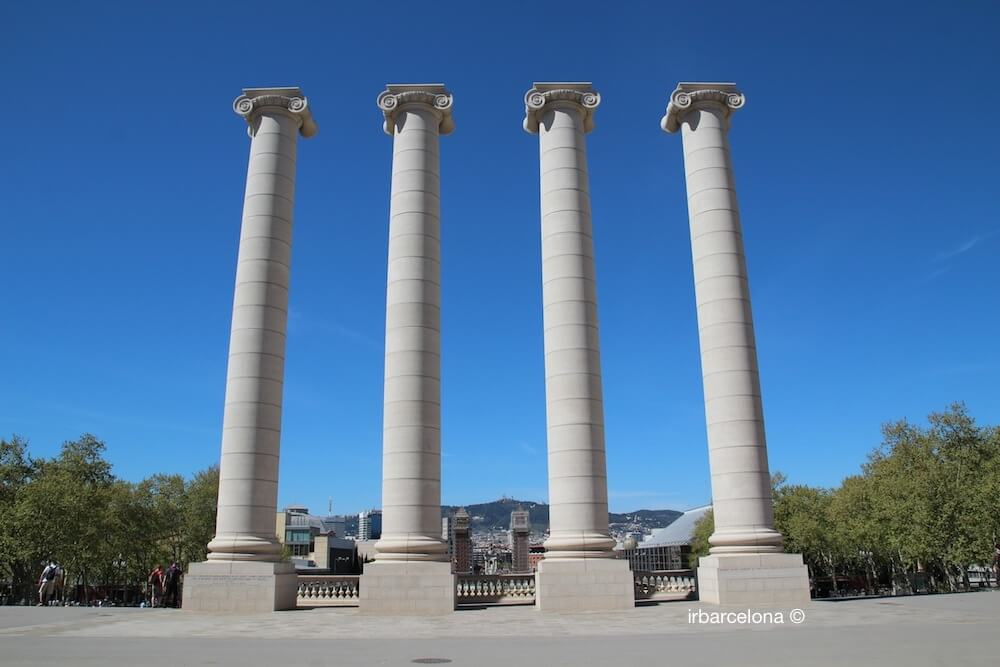
Updated May 26 2023
On 27th February 2011 the Four Columns of Josep Puig i Cadafalch (in catalan Les Quatres Columnes de Josep Puig i Cadafalch, or Les Quatre Columnes as they were originally know by their Catalan name) were at last restored. They are an almost exact replica of the original monument, built in 1919 by the architect, town planner and politician Josep Puig i Cadafalch, and destroyed in 1928 under the dictatorship of Miguel Primo de Rivera.
The origin of the four columns of Josep Puig i Cadafalch
The chosen place for the celebrations of Barcelona’s International Exposition of 1929 was the mountain at Montjuïc, and the city took full advantage of this in developing the mountain itself, as well as making some much-needed urban improvements to the surrounding areas.
This was all commissioned by Josep Puig i Cadafalch, who was also curator of the Exposition, and he wanted to erect a monument that would be seen as a symbolic representation of Catalunya. He designed four large columns, representing the four stripes of the Catalan flag, which were finally erected in 1919. It was the first work to be completed out of the many that followed for the Exposition.

At the time, the site chosen for the columns was at the foot of the ‘Palau Nacional de Montjuïc’ (now the MNAC building), in the same place where the Magic Fountain of Montjuïc now stands.
In 1928, during the dictatorship of Miguel Primo de Rivera, the Four Columns were demolished, as part of the general effort to get rid of any symbol of Catalan identity during the International Exposition.
The current columns
Thanks to the initiative of the ‘Xarxa d’Entitats Cíviques i Culturals dels Països Catalans pels Drets i les Llibertats Nacionals’ with the support of the city council, the restoration of the Josep Puig i Cadafalch was eventually carried out. Because the original site was by then occupied by the Magic Fountain of Montjuïc, it was decided that the columns should go just behind the fountain, in the Plaça del Marquès de Foronda.
Crowned by iconic capitals, just as the original columns were, and constructed with a mixture of cement, granite and white marble, the columns are of the same natural colour of the stone at Montjuïc, which was used in the original construction. In fact, the current Four Columns are an almost exact replica of the work of Puig i Cadafalch, although at a height of 18.7 metres (or 20 metres including the base), they are somewhat shorter than the originals in order to avoid them being taller than the two buildings at either side – the Victoria Eugenia Palace and the Alfonso XIII Palace.
At the foot of the columns you can read:
in catalan: “Restitució, com a acte de justícia històrica, de les quatre columnes enderrocades per la dictadura l’any 1928 pel seu caràcter de símbol de Catalunya”.
in english: “Restoration, as an act of historical justice, of the Four Columns demolished by the dictatorship in 1928, for being a symbol of Catalunya”.

The area in which the columns are located is really quite beautiful, so it’s naturally a place where tourists get their cameras out. If you’d like to benefit from a great panoramic view of the Four Columns, we recommend that you go up to the steps that you would use to access the MNAC (the Museu Nacional d’Art de Catalunya), as it offers a great viewpoint of both the Four Columns and the Montjuïc Fountain, as well as of the Avinguda Reina Maria Cristina, the Plaça d’Espanya and Les Arenes.
We suggest visiting the area at night-time, when the columns are illuminated by spotlights from the Palau Nacional de Montjuïc. This gives the monument a wonderful silhouette, ensuring an even more spectacular view, especially with the ‘son et lumière’ shows at the Magic Fountain to entertain you. Don’t forget your camera!
Photo gallery
Map
Address
Plaça (square) del Marquès de Foronda, Barcelona.
How to get there?
Metro: Espanya (lines 1 and 3).
Buses: lines 9, 13, 27, 30, 37, 50, 55, 56, 57, 65, 79, 109, 157, 165 and toursit bus.
By foot: Easily accessible by foot if you’re in the areas of Montjuïc or Poble Sec.
Nearby places of interest
Magic Fountain of Montjuïc
MNAC
Palauet Albéniz (Palace)
Barcelona’s Olympic Stadium
Palau Sant Jordi






